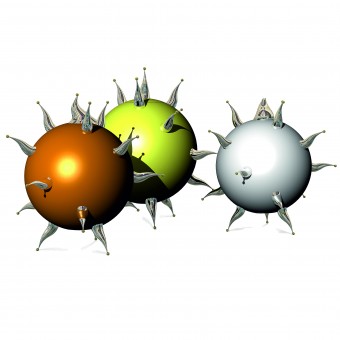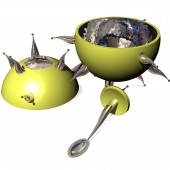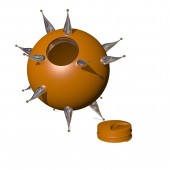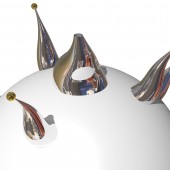
| THE AWARD |
| CATEGORIES |
| REGISTRATION |
| SUBMIT YOUR WORK |
| ENTRY INSTRUCTIONS |
| TERMS & CONDITIONS |
| PUBLICATIONS |
| DATES & FEES |
| METHODOLOGY |
| CONTACT |
| WINNERS |
| PRESS ROOM |
| GET INVOLVED |
| DESIGN PRIZE |
| DESIGN STORE |
| THE AWARD | JURY | CATEGORIES | REGISTRATION | PRESS | WINNERS | PUBLICATIONS | ENTRY INSTRUCTIONS |
Urchin Table Cruet/Condiment Set by Clive and Tina Bullivant |
Home > Winners > Design #23686 >Interview |
 |
|
FS: What is the main principle, idea and inspiration behind your design?
CB: I have a passion for products designed using natural forms and living near the coast take much of my inspiration from the sea and it's environment. This table cruet was inspired by sea urchins and corals and the vibrant colours and forms they have
FS: What has been your main focus in designing this work? Especially what did you want to achieve?
CB: I am used to producing pieces for fine dining and wanted something that could bridge the gap between this and casual eating arrangements without the need to keep something as a 'best set'.
FS: What are your future plans for this award winning design?
CB: I am already working on a family of dinner ware products that could be marketed as a complete range.
FS: How long did it take you to design this particular concept?
CB: This design took 7 months to realize alongside my other work.
FS: Why did you design this particular concept? Was this design commissioned or did you decide to pursuit an inspiration?
CB: The design is quite indulgent and was the result of pursuing a personal interest.
FS: Is your design being produced or used by another company, or do you plan to sell or lease the production rights or do you intent to produce your work yourself?
CB: The design remains as an initial concept at the moment, but I would hope that a manufacturer would recognize the potential and I would be happy to sell the design on.
FS: What made you design this particular type of work?
CB: I am already a multi-award winning designer of silverware but really wanted to break free of the constraints of precious metals and exploit exciting and more modern production materials in everyday use.
FS: Where there any other designs and/or designers that helped the influence the design of your work?
CB: My interest in design is pretty eclectic but this work is entirely my own inspiration.
FS: Who is the target customer for his design?
CB: My focus group for this project were 25- 50 year olds for whom dining and dinner parties form an important part of their social life.
FS: What sets this design apart from other similar or resembling concepts?
CB: The whole concept was to produce a design that people would want to handle and that would have a strong decorative aesthetic making it as much a table sculpture as a practical product.
FS: How did you come up with the name for this design? What does it mean?
CB: The name 'Urchin' was obvious as it relares directly to the inspiration for the design and is something that everyone will know and relate to.
FS: Which design tools did you use when you were working on this project?
CB: I started with freehand sketching as I do with all my designs, before developing the concept through CAD modelling. I then tested the ergonomics with simple foam mock-ups.
FS: What is the most unique aspect of your design?
CB: The use of polymer body shells allowing strong colours to be used and the overall visual impact of the design are it's most unique features.
FS: Who did you collaborate with for this design? Did you work with people with technical / specialized skills?
CB: I developed this design entirely on my own, relying on my own skills and knowledge of materials and manufacture.
FS: What is the role of technology in this particular design?
CB: The design relies on well established technologies for it's production.
FS: Is your design influenced by data or analytical research in any way? What kind of research did you conduct for making this design?
CB: I worked with a range of target users to find out how they socialized, and what importance they placed on their tableware when entertaining. This helped me to understand the sort of products they aspired to but weren't prepared to buy.
FS: What are some of the challenges you faced during the design/realization of your concept?
CB: The main challenges were firstly visual in achieving a balance between the contemporary and sophisticated which was achieved through good feedback with the focus group. Secondly the ergonomic challenge which affected the selection of materials, size and position and number of spines. Thirdly the assembly of the components which 'plug' together ensuring a secure and stable outcome.
FS: How did you decide to submit your design to an international design competition?
CB: The response I received from the focus group was very positive and suggested that there would be a significant global market which I believed this competition would help me access.
FS: What did you learn or how did you improve yourself during the designing of this work?
CB: I was able to explore what makes an object desirable and valued even when its material cost is relatively low.
FS: Thank you for providing us with this opportunity to interview you.
A' Design Award and Competitions grants rights to press members and bloggers to use parts of this interview. This interview is provided as it is; DesignPRWire and A' Design Award and Competitions cannot be held responsible for the answers given by participating designers.
| SOCIAL |
| + Add to Likes / Favorites | Send to My Email | Comment | View Press-Release |




